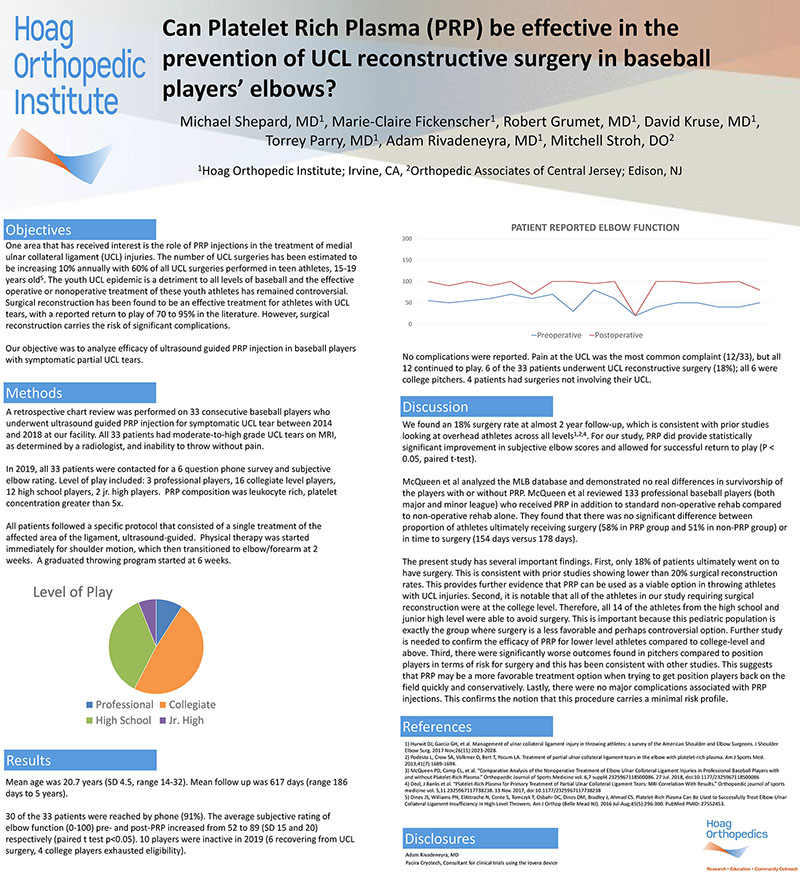
Hover to pan and click to magnify. Click again to pan at full screen.
Michael Shepard, MD, Marie-Claire Fickenscher, Robert Grumet, MD, David Kruse, MD, Torrey Parry, MD, Adam Rivadeneyra, MD, Mitchell Stroh, DO
Michael Shepard, MD, Marie-Claire Fickenscher, Robert Grumet, MD, David Kruse, MD, Torrey Parry, MD, Adam Rivadeneyra, MD, Mitchell Stroh, DO
Hoag Orthopedic Institute; Irvine, CA, Orthopedic Associates of Central Jersey; Edison, NJ
Objectives
One area that has received interest is the role of PRP injections in the treatment of medial ulnar collateral ligament (UCL) injuries. The number of UCL surgeries has been estimated to be increasing 10% annually with 60% of all UCL surgeries performed in teen athletes, 15-19 years old5. The youth UCL epidemic is a detriment to all levels of baseball and the effective operative or nonoperative treatment of these youth athletes has remained controversial. Surgical reconstruction has been found to be an effective treatment for athletes with UCL tears, with a reported return to play of 70 to 95% in the literature. However, surgical reconstruction carries the risk of significant complications. Our objective was to analyze efficacy of ultrasound guided PRP injection in baseball players with symptomatic partial UCL tears.
Methods
A retrospective chart review was performed on 33 consecutive baseball players who underwent ultrasound guided PRP injection for symptomatic UCL tear between 2014 and 2018 at our facility. All 33 patients had moderate-to-high grade UCL tears on MRI, as determined by a radiologist, and inability to throw without pain. In 2019, all 33 patients were contacted for a 6 question phone survey and subjective elbow rating. Level of play included: 3 professional players, 16 collegiate level players, 12 high school players, 2 jr. high players. PRP composition was leukocyte rich, platelet concentration greater than 5x. All patients followed a specific protocol that consisted of a single treatment of the affected area of the ligament, ultrasound-guided. Physical therapy was started immediately for shoulder motion, which then transitioned to elbow/forearm at 2 weeks. A graduated throwing program started at 6 weeks.
Results
Mean age was 20.7 years (SD 4.5, range 14-32). Mean follow up was 617 days (range 186 days to 5 years). 30 of the 33 patients were reached by phone (91%). The average subjective rating of elbow function (0-100) pre- and post-PRP increased from 52 to 89 (SD 15 and 20) respectively (paired t test p<0.05). 10 players were inactive in 2019 (6 recovering from UCL surgery, 4 college players exhausted eligibility).
Discussion
We found an 18% surgery rate at almost 2 year follow-up, which is consistent with prior studies looking at overhead athletes across all levels1,2,4. For our study, PRP did provide statistically significant improvement in subjective elbow scores and allowed for successful return to play (P < 0.05, paired t-test). McQueen et al analyzed the MLB database and demonstrated no real differences in survivorship of the players with or without PRP. McQueen et al reviewed 133 professional baseball players (both major and minor league) who received PRP in addition to standard non-operative rehab compared to non-operative rehab alone. They found that there was no significant difference between proportion of athletes ultimately receiving surgery (58% in PRP group and 51% in non-PRP group) or in time to surgery (154 days versus 178 days). The present study has several important findings. First, only 18% of patients ultimately went on to have surgery. This is consistent with prior studies showing lower than 20% surgical reconstruction rates. This provides further evidence that PRP can be used as a viable option in throwing athletes with UCL injuries. Second, it is notable that all of the athletes in our study requiring surgical reconstruction were at the college level. Therefore, all 14 of the athletes from the high school and junior high level were able to avoid surgery. This is important because this pediatric population is exactly the group where surgery is a less favorable and perhaps controversial option. Further study is needed to confirm the efficacy of PRP for lower level athletes compared to college-level and above. Third, there were significantly worse outcomes found in pitchers compared to position players in terms of risk for surgery and this has been consistent with other studies. This suggests that PRP may be a more favorable treatment option when trying to get position players back on the field quickly and conservatively. Lastly, there were no major complications associated with PRP injections. This confirms the notion that this procedure carries a minimal risk profile.
References
1) Hurwit DJ, Garcia GH, et al. Management of ulnar collateral ligament injury in throwing athletes: a survey of the American Shoulder and Elbow Surgeons. J Shoulder Elbow Surg. 2017 Nov;26(11):2023-2028. 2) Podesta L, Crow SA, Volkmer D, Bert T, Yocum LA. Treatment of partial ulnar collateral ligament tears in the elbow with platelet-rich plasma. Am J Sports Med.
2013;41(7):1689-1694. 3) McQueen PD, Camp CL, et al. “Comparative Analysis of the Nonoperative Treatment of Elbow Ulnar Collateral Ligament Injuries in Professional Baseball Players with and without Platelet-Rich Plasma.” Orthopaedic Journal of Sports Medicine vol. 6,7 suppl4 2325967118S00086. 27 Jul. 2018, doi:10.1177/2325967118S00086 4) Deal, J Banks et al. “Platelet-Rich Plasma for Primary Treatment of Partial Ulnar Collateral Ligament Tears: MRI Correlation With Results.” Orthopaedic journal of sports medicine vol. 5,11 2325967117738238. 13 Nov. 2017, doi:10.1177/2325967117738238 5) Dines JS, Williams PN, ElAttrache N, Conte S, Tomczyk T, Osbahr DC, Dines DM, Bradley J, Ahmad CS. Platelet-Rich Plasma Can Be Used to Successfully Treat Elbow Ulnar Collateral Ligament Insufficiency in High-Level Throwers. Am J Orthop (Belle Mead NJ). 2016 Jul-Aug;45(5):296-300. PubMed PMID: 27552453.
Disclosures
Adam Rivadeneyra, MD
Pacira Cryotech, Consultant for clinical trials using the Iovera device

Present with Google Meet
Invite as many as 30 people, and present your poster in high definition. Transcription option is available. Free to use.
DISQUS COMMENTS WILL BE SHOWN ONLY WHEN YOUR SITE IS ONLINE